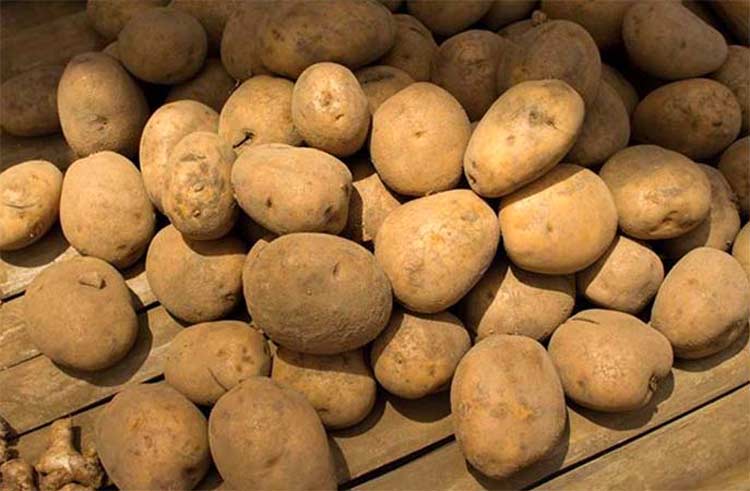
Farida Akhter
After repeated failure of Bt Brinjal another food crop, very common vegetable Potato is genetically modified and waiting for approval for field cultivation. This is Blight Resistant Potato (RB Potato). This is a matter of concern as Bangladesh is being used for easy introduction of GM crops for its weak regulatory authority.
Failure of field cultivation of Bt brinjal, the so-called first GM crop in Bangladesh, did not stop Bangladesh Agricultural Research Institute (BARI) from abusing the authority and resources of a public institution.
Without clarifying the criticisms against Bt brinjal field trial and questions of bio-safety, BARI is applying for approval of the blight resistant (RB) potato, another GM food crop for commercial release.
The National Technical Committee for Crop Biotechnology (NTCCB) under the Ministry of Agriculture will forward the application to the National Committee on bio-safety under the Ministry of Environment and Forests (MOEF) for approval. It seems they are all set to get the approval early 2017.
In the case of Bt brinjal, the NCB was quick to give such approval, but it was based on seven conditions, of which none was met, and the NCB did not follow up with any action. One important condition was to market the Bt brinjal with a label, which was grossly violated.
No one knows where the Bt brinjals are sold and who is consuming them. The Ministry of Environment and Forest did not play any role in ensuring the conditions it has set for approval. It also failed to safeguard the biodiversity, environment, and human health under the Cartegena Protocol on bio-safety, in which Bangladesh is a signatory.
It has shown its failure to properly assess the potential impact of introducing genetically modified crops in a country like Bangladesh. Its passive role as an authority of just giving approvals is violating the international treaties that the government has signed.
Is the same story going to be repeated in the case of GM potato? The genetically modified potato or the Late Blight Resistant (RB) potato is developed by scientists from BARI’s Tuber Crops Research Centre (TCRC) in cooperation with the Agricultural Biotechnology Support Project II (ABSPII), a USAID-funded consortium of public and private sector institutions since 2006.
They developed the transgenic lines by crossing the popular Bangladeshi varieties (diamant and cardinal) with transgenic variety Katahdin at Wisconsin University and Indonesian University.
More than a billion people eat potatoes, and its worldwide production exceeds 300 million metric tonnes. That means, it has a huge global market
RB gene was taken from wild potato varieties and was infused into the Katahdin in the US and crossed with diamant and cardinal — two popular potato varieties in Bangladesh.
For GM food crops, the promoters take a multi-country approach. In the case of Bt brinjal, the research was carried out in India, the Philippines, and Bangladesh under ABSPII. But India and the Philippines did not allow its commercial release, while in Bangladesh, despite protest from farmers and environmental groups, GMO promoters took advantage of weak regulatory mechanism for the release of GM crops. GM potato is also being developed in India, Indonesia, and Uganda apart from Bangladesh.
Why do we need a GM potato? Of course, the GM promoters have a “reason” as they had for Bt brinjal. In the case of Bt brinjal, they wanted to “save” farmers from spraying huge amounts of pesticides for Fruit and Shoot Borer (FSB), although Bt brinjal itself was not free from pesticide at all.
UBINIG investigations in Bt brinjal fields showed that 35 types of pesticides, including acaricide, insecticide, and fungicide, were sprayed several times in the Bt brinjal fields as per direction of the supervising officials of DAE. Bangladesh Crop Protection Association (BCPA) estimated the annual volume of fungicide applications in potato fields at 400 to 500 tonnes to save from Late Blight.
Potato is not only a vegetable, it is the staple food after rice and wheat. According to the International Potato Centre (CIP), more than a billion people eat potatoes, and its worldwide production exceeds 300 million metric tonnes. That means, it has a huge global market. Once GM potato can be “established” as successful in a country, GM potato will be able to control the global market.
So far, the arguments in favour of the GM brinjal and potato were to save from pests and late blight which affects production. To convince the public, they talk about pesticide and fungicides as compelling issues. Saving a crop from one pest or one form of infestation is a wrong interpretation of crop production.
Every crop may have several forms of attack. Genetic modification takes care of only one trait. It does not say whether the GM crop has any food value or whether farmers will earn a better income. Bt brinjal has shown economic failures of the farmers. They could not get the return to their investment. So far, the problem has been of low prices with good harvest of potatoes. This year with a good harvest of potatoes, farmers were offered a low price of Tk4 per kg, while the cost of production is Tk10.
Newspaper reports show that farmers in north Bengal could only buy a cup of tea by selling 1kg of potato. The story is similar for brinjals and other vegetables during the season. We do not need any genetic engineering to solve this problem. What we need is a well-managed pricing policy for agricultural crops, particularly perishable food crops.
This article was published in Dhaka Tribune on 18 January, 2017